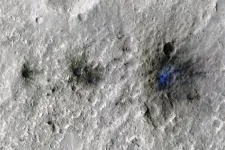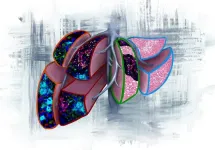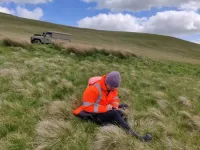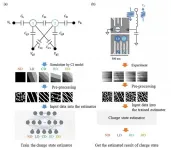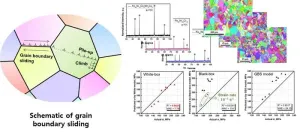(Press-News.org) In brief:
For the first time, researchers use seismic data to estimate a global meteorite impact rate showing meteoroids the size of a basketball impact Mars on a near daily basis.
Impact-generated seismic signals show meteorite impacts to be 5-times more abundant than previously thought.
Seismic data offers a new tool, in addition to observational data, for calculating meteorite impact rates and planning future Mars missions
An international team of researchers, co-lead by ETH Zurich and Imperial College London, have derived the first estimate of global meteorite impacts on Mars using seismic data. Their findings indicate between 280 to 360 meteorites strike the planet each year forming impact craters greater than 8 metres (about 26 feet) across. Geraldine Zenhaeusern who co-led the study commented, "This rate was about five times higher than the number estimated from orbital imagery alone. Aligned with orbital imagery, our findings demonstrate that seismology is an excellent tool for measuring impact rates."
Seismic “chirp” signals new class of quakes
Using data from the seismometer deployed during the NASA InSight Mission to Mars, researchers found that 6 seismic events recorded in the near proximity of the station had been previously identified as meteoric impacts (Garcia et al., 2023) - a process enabled by the recording of a specific acoustic atmospheric signal generated when meteorites enter the Martian atmosphere. Now, Zenhäusern, ETH Zurich, co-lead, Natalia Wójcicka, Imperial College London, and the research team have found that these 6 seismic events belong to a much larger group of marsquakes, so called very high frequency (VF) events. The source process of these quakes occurs much faster than for a tectonic marsquake of similar size. Where a normal magnitude 3-quake on Mars takes several seconds, an impact-generated event of the same size takes only 0.2 seconds or less, due to the hypervelocity of the collision. By analysing marsquake spectra, a further 80 marsquakes were identified that are now thought to be caused by meteoroid strikes.
Their research quest began in December 2021, a year before accumulated dust on the solar panels put an end to the InSight mission, when a large distant quake recorded by the seismometer reverberated a broadband seismic signal throughout the planet. Remote sensing associated the quake with a 150-metre-wide crater. To confirm, the InSight team partnered with Mars Reconnaissance Orbiter (MRO) Context Camera (CTX) to search for other fresh craters that would match the timing and location of the seismic events detected by InSight. The teams’ detective work paid off and they were lucky to find a second fresh crater over a 100-metres (320 feet) in diameter. Smaller craters, however, formed when basketball-sized meteoroids strike the planet and which should be far more common, remained elusive. Now, the number of meteorite strikes is newly estimated by the occurrence of these special high-frequency quakes.
First meteorite impact rate from seismic data
Approximately 17,000 meteorites fall to Earth each year, but unless they streak across the night’s sky, they are rarely noticed. Most meteors disintegrate as they enter Earth’s atmosphere, but on Mars the atmosphere is 100 times thinner leaving its surface exposed to larger and more frequent meteorite strikes.
Until now, planetary scientists have relied on orbital images and models inferred from well-preserved meteorite impacts on the Moon but extrapolating these estimates to Mars proved challenging. Scientists had to account for the stronger gravitational pull of Mars and its proximity to the asteroid belt, which both mean that more meteorites hit the red planet. On the other hand, regular sandstorms result in craters that are much less well-preserved than those on the Moon, and, therefore, not as easily detected with orbital imagery. When a meteorite strikes the planet, the seismic waves of the impact travel through the crust and mantle and can be picked up by seismometers.
Wójcicka explains, "We estimated crater diameters from the magnitude of all the VF-marsquakes and their distances, then used it to calculate how many craters formed around the InSight lander over the course of a year. We then extrapolated this data to estimate the number of impacts that happen annually on the whole surface of Mars."
Zenhäusern adds, "While new craters can best be seen on flat and dusty terrain where they really stand out, this typ of terrain covers less than half of the surface of Mars. The sensitive InSight seismometer, however, could hear every single impact within the landers' range."
Insight into Mars age and future missions
Much like the lines and wrinkles on our face, the size and density of craters from meteorite strikes reveal clues about the age of different regions of a planetary body. The less craters, the younger the region of the planet. Venus, for example, has almost no visible craters because its surface is continually reworked by volcanism, while Mercury and the Moon with their ancient surfaces are heavily cratered. Mars falls in between these examples, with some old and some young regions that can be distinguished by the number of craters.
New data shows, an 8-metre (26-feet) crater happens somewhere on the surface of Mars nearly every day and a 30-metre (98-feet) crater occurs about once a month. Since hypervelocity impacts cause blast zones that are easily 100 times larger in diameter than the crater, knowing the exact number of impacts is important for the safety of robotic, but also future human missions to the red planet.
"This is the first paper of its kind to determine how often meteorites impact the surface of Mars from seismological data – which was a level one mission goal of the Mars InSight Mission,” says Domenico Giardini, Professor of Seismology and Geodynamics at ETH Zurich and co-Principal Investigator for the NASA Mars InSight Mission. “Such data factors into the planning for future missions to Mars."
According to Zenhäusern and Wójcicka, the next steps in advancing this research involve the use of machine learning technologies to aid researchers in identifying further craters in satellite images and identifying seismic events in the data.
END
New class of Mars quakes reveals daily meteorite strikes
2024-06-28
ELSE PRESS RELEASES FROM THIS DATE:
Gene therapy halts progression of rare genetic condition in young boy
2024-06-28
When Michael Pirovolakis received an individualized gene therapy in a single-patient clinical trial at The Hospital for Sick Children (SickKids) in March 2022, the course of his condition was dramatically altered.
Michael has spastic paraplegia type 50 (SPG50), an “ultra-rare” progressive neurodegenerative disorder that causes developmental delays, speech impairment, seizures, a progressive paralysis of all four limbs, and typically fatal by adulthood. Approximately 80 children around the world ...
New predictors of metastasis in patients with early-stage pancreatic cancer
2024-06-28
Researchers at Weill Cornell Medicine with an international team have used liver biopsies to identify cellular and molecular markers that can potentially be used to predict whether and when pancreatic cancer will spread to an individual’s liver or elsewhere, such as the lung.
The study, published on June 28 in Nature Medicine, proposes that information from a liver biopsy—a small tissue sample collected for lab analysis—when pancreatic cancer is diagnosed may help guide doctors in personalizing treatment, such as liver-directed immunotherapies, before cancer cells have the chance to metastasize.
Only 10 percent of people with pancreatic ...
Climate change to shift tropical rains northward
2024-06-28
A study led by a UC Riverside atmospheric scientist predicts that unchecked carbon emissions will force tropical rains to shift northward in the coming decades, which would profoundly impact agriculture and economies near the Earth's equator.
The northward rain shift would be caused by complex changes in the atmosphere spurred by carbon emissions that influence the formation of the intertropical convergence zones. Those zones are essentially atmospheric engines that drive about a third of the world’s precipitation, Liu and his co-authors report in a paper published Friday, June 28, in the journal Nature Climate Change.
Tropical ...
City of Hope study suggests changing the gut microbiome improves health outcomes for people newly diagnosed with metastatic kidney cancer
2024-06-28
LOS ANGELES — Physician scientists from City of Hope, one of the largest cancer research and treatment organizations in the United States, found that people with metastatic kidney cancer who orally took a live biotherapeutic product called CBM588 while in treatment with immunotherapy and enzymatic tyrosine kinase inhibitors experienced improved health outcomes. The phase 1 trial was published today in Nature Medicine.
Microorganisms in the gut modulate the immune system. City of Hope researchers are now in discussions with the global SWOG Cancer ...
Surprising meteorite impact rate on Mars can act as ‘cosmic clock’
2024-06-28
Seismic signals have suggested Mars gets hit by around 300 basketball-sized meteorites every year, providing a new tool for dating planetary surfaces.
The new research, led by scientists at Imperial College London and ETH Zurich working as part of NASA's InSight mission, has shed light on how often ‘marsquakes’ caused by meteorite impacts occur on Mars.
The researchers found that Mars experiences around 280 to 360 meteorite impacts every year that produce craters larger than eight metres in diameter and shake the red planet’s ...
Air pollution exposure during childhood linked directly to adult bronchitis symptoms in new research
2024-06-28
A new study brings fresh revelations about the connection between early-life exposure to air pollution and lung health later in life. A research team led by the Keck School of Medicine of USC has shown that exposure to air pollution during childhood is directly associated with bronchitis symptoms as an adult.
To date, many investigations in the field have established intuitive links that are less direct than that: Air pollution exposure while young is consistently associated with lung problems during childhood — and childhood lung problems are consistently associated with lung issues as an adult.
The current study, published in the American Journal of Respiratory ...
Kids given ‘digital pacifiers’ to calm tantrums fail to learn how to regulate emotions, study finds
2024-06-28
Children learn much about self-regulation – that is affective, mental, and behavioral responses to certain situations – during their first few years of life. Some of these behaviors are about children’s ability to choose a deliberate response over an automatic one. This is known as effortful control, which is learned from the environment, first and foremost through children’s relationship with their parents.
In recent years, giving children digital devices to control their responses to emotions, especially if they’re negative, has ...
No evidence that England’s new ‘biodiversity boost’ planning policy will help birds or butterflies
2024-06-28
A new legal requirement for developers to demonstrate a biodiversity boost in planning applications could make a more meaningful impact on nature recovery if improvements are made to the way nature’s value is calculated, say researchers at the University of Cambridge.
From 2024, the UK’s Environment Act requires planning applications to demonstrate an overall biodiversity net gain of at least 10% as calculated using a new statutory biodiversity metric.
The researchers trialled the metric by using it to calculate the biodiversity value of 24 sites across England. These sites have all been monitored over the long-term, allowing the team to compare biodiversity ...
Visual explanations of machine learning models to estimate charge states in quantum dots
2024-06-28
A group of researchers has successfully demonstrated automatic charge state recognition in quantum dot devices using machine learning techniques, representing a significant step towards automating the preparation and tuning of quantum bits (qubits) for quantum information processing.
Semiconductor qubits use semiconductor materials to create quantum bits. These materials are common in traditional electronics, making them integrable with conventional semiconductor technology. This compatibility is why scientists consider them strong candidates for future ...
The future of metals research with artificial intelligence
2024-06-28
A research team led by Professor Hyoung Seop Kim from the Graduate Institute of Ferrous & Eco Materials Technology and the Department of Materials Science and Engineering and Jeong Ah Lee, a PhD candidate, from the Department of Materials Science and Engineering, in recent collaboration with Professor Figueiredo from Universidade Federal de Minas Gerais's Department of Metallurgical and Materials Engineering in Brazil, has developed an optimal artificial intelligence model to predict the yield strength of various metals, effectively addressing traditional cost and time limitations. This research has been published in the online edition of Acta Materialia, an ...
